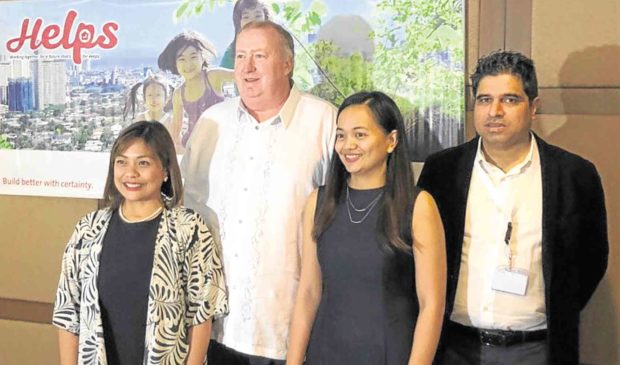
HELPING HANDS. Holcim CEO John Stull (second from left) with Holcim officials Cara Ramirez, Steph Fogoso and Ram Maganti.
A future that’s for keeps.”
This is both the vision and mission Holcim Philippines Inc., which the building solutions company is working on through its recently launched campaign “Holcim Helps.”
Under the campaign, Holcim aims to improve the lives of close to 400,000 Filipinos through programs for shelter, infrastructure, education, livelihood, health, and safety as part of the company’s commitments to social responsibility and sustainability.
Over 300,000 people in communities around Holcim’s plant locations have already benefited from the company’s corporate citizenship programs, and by 2020, Holcim plans to help around 100,000 more, says Ann Claire Ramirez, communications head of Holcim Philippines.
Holcim Philippines works with the Technical Education and Skills Development Authority (Tesda) to certify these masons, a group that has grown to over 5,000 since Galing Mason’s inception in 2010, Ramirez adds. The company also works with the Department of Social Welfare and Development (DSWD) in providing financial education to barangays (villages) surrounding their plants.
Headquartered in Taguig City, Holcim Philippines operates plants and terminals in nine locations around the country. They have cement plants in Bacnotan, La Union; Norzagaray, Bulacan; Lugait, Misamis Oriental; and Davao City. Their terminals are situated in Manila (their dry mix plant can also be found here), Iloilo City and Calaca in Batangas; while their paper bag and grinding plants can be found in Calumpit, Bulacan, and Mabini, Batangas.
It is the communities in these areas which the company wants to strengthen their collaboration with, says Holcim Philippines president and CEO John Stull.
“‘Holcim Helps’ underscores our goal of making our programs a collaboration with our communities instead of charitable donations as the primary form of assistance,” adds Stull.
The company’s sustainability efforts also involves its commitment to improve its environmental footprint, says Stephanie Frogoso, Holcim Philippines environmental manager.
Under its Sustainability Plan 2030, the company plans to further reduce its level of carbon emissions by 40 percent, and its use of freshwater by 30 percent in cement production in the next 12 years.
Frogoso also cites the company’s continued efforts to use alternative fuel, which they generate from qualified wastes using their waste management unit Geocycle.
“Our goal is to replace 30 percent of the traditional fuel we use [in production] to alternative fuel by 2030,” says Frogoso.
Ramirez says they offer waste management as a service to their clients—a service they deem critical, as solid waste management still seems to be a challenge for the country.
“These initiatives help improve the efficiency of our operations, thus generating savings for our business,” says Stull. “But more importantly, our programs allow our company to further support our commitment to be a partner in helping the country build a better future.”